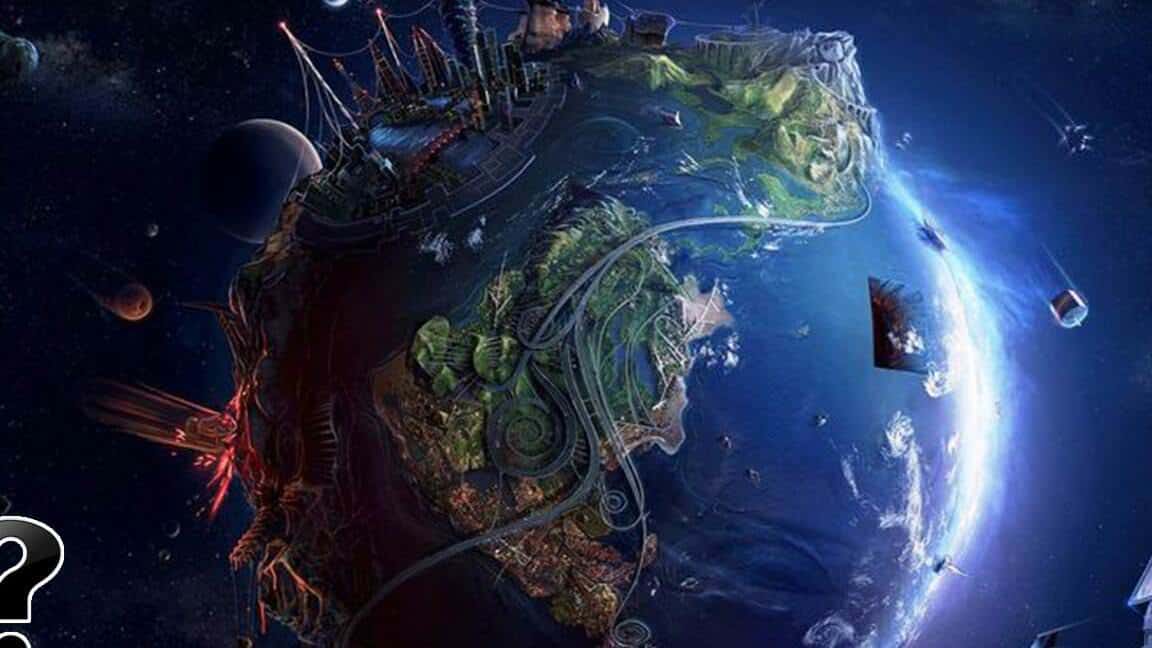The current map of the Earth is no longer accurate. Africa is undergoing significant tectonic activity, causing it to crack along its seams. North America has shifted by half a meter, altering its geographical position. The Alps and Mount Everest are experiencing rapid growth, surpassing their previous heights. Additionally, a new island has emerged in the Pacific Ocean. These transformations are raising questions about the future state of our planet. How will the world change in the coming millennia? And why is it necessary for Africans to learn Hindi? These intriguing topics will be explored in-depth on the program “Incredibly Interesting Stories” hosted by Alexei Korzin on REN TV.
The future division of Africa
In the future, Somalia will migrate towards India, while new Carpathian mountains will emerge in Eurasia. These are the predictions made by scientists from Utrecht University who have modeled the Earth’s shape in 200 million years. According to their research, the world map will undergo drastic changes. The continents of South and North America will collide, and Africa will experience a fragmentation.
“The region currently occupied by Somalia will detach from Africa and merge with India. This collision will give rise to the massive Somali Mountains, which will have a similar curved shape to the Carpathians,” explained paleogeographer Dauwe van Hinsbergen.– stated paleogeographer Dauwe van Hinsbergen.
Scientists confirm that no one currently alive will experience this “movement”. However, the splitting of Africa has already commenced. A few years ago, a massive crevice emerged in the southwestern region of Kenya. This fissure stretches for several kilometers and reaches a depth of 15 meters, making it even visible from outer space.
“The crevice did not manifest suddenly; this process has been ongoing for millions of years. The Somali and Nubian lithospheric plates are gradually drifting apart, creating gaps in the Earth’s surface. Typically, these voids are filled with volcanic dust, but heavy rainfall in Africa has eroded this layer, resulting in the opening of the fissure,” explained geologist Ben Andrews.
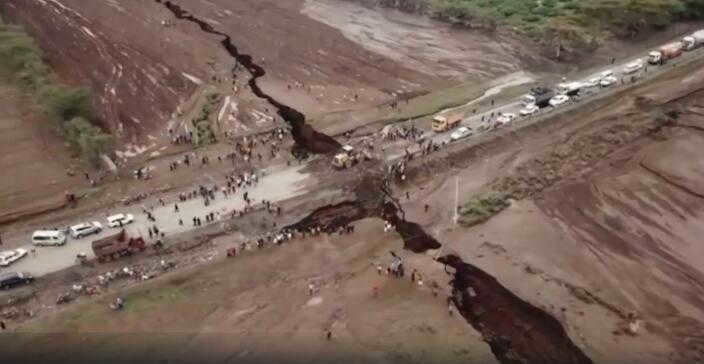
The formation of a new ocean
According to scientific predictions, the ongoing crack in Africa will eventually lead to the formation of a new ocean, effectively dividing the continent into two parts. Experts emphasize that this is not an extraordinary phenomenon, as continents have undergone similar splits in the past.
“The separation of South America and Africa was influenced by similar processes, as they were originally part of a single continent known as Western Gondwana. Even earlier, around 300 million years ago, all continents were united as a landmass called Pangaea,” stated Ben Andrews, a leading expert in the field.
The movement of the Earth’s crust, or lithospheric plates, is responsible for the drifting of the continents. As these plates collide and separate, the continents gradually shift positions. However, the movement is so slow and the distances covered are so minuscule that it goes unnoticed by people. Nevertheless, this continuous motion never ceases. Scientists leverage this data to forecast natural calamities and facilitate the extraction of freshwater.
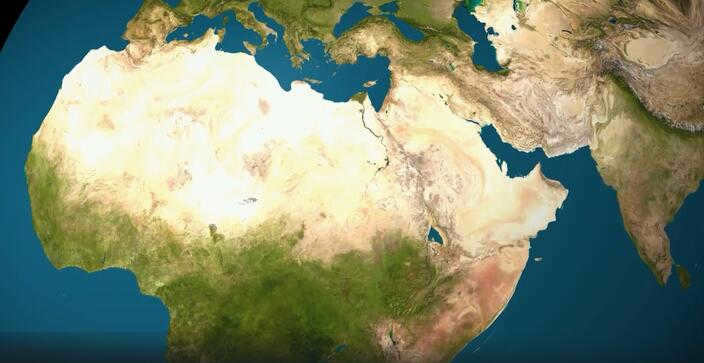
A brand new landmass
The primary cause of volcanic eruptions, earthquakes, and tsunamis is the movement of the Earth’s crust. However, without this phenomenon, there would be no majestic mountains adorning our planet. In certain regions like Turkey and Iran, mountain ranges have formed due to the shifting of the Arabian Plate.
Every year, this plate gradually moves beneath the Eurasian Plate by about 3 centimeters. While this may seem insignificant, it has a profound impact on the shape of our planet. For instance, the Zagros Mountains in Iraqi Kurdistan experience a yearly elevation increase of 5-10 millimeters.
“During the occurrence of a volcanic eruption, there is a significant discharge of magma, which eventually solidifies and leads to the creation of fresh cavities. If these cavities elevate above the ocean’s surface, a new landmass in the form of an island emerges,” stated Vladislav Zhukov, who serves as a member of Rosprirodnadzor’s Scientific and Technical Council.
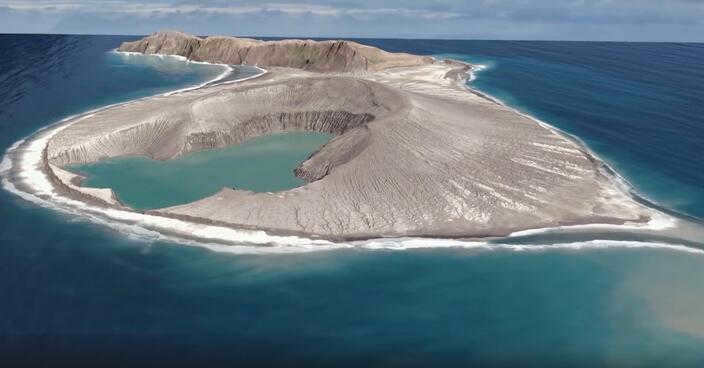
What happened to the enigmatic island?
Typically, such islands have a short lifespan as they are eroded by winds and waves. In just a few months, there is no evidence of their existence. However, this time the situation was quite the opposite. The island continued to thrive and within six years, it had doubled in size. Three years ago, NASA experts embarked on an expedition to explore the island. Expedition leader James Garvin made a remarkable discovery – the island was inhabited.
“The island has already been inhabited by several species of plants and birds. Our goal is to assess its suitability for human settlement. The island’s surface bears resemblance to the soil found on other planets. This study will aid us in our future space colonization endeavors,” explained James Garvin, a researcher at the Space Flight Center.
Thankfully, humans haven’t had the chance to explore this newfound land. In January of last year, the underwater volcano Hunga-Tonga reawakened. The eruption was estimated to have a power equivalent to 10 megatons of TNT, making it 500 times stronger than the atomic bomb blast in Hiroshima.
Ash blanketed the capital of Tongo, a tsunami struck the Japanese prefecture of Kochi, and Moscow’s sensors detected a sudden spike in atmospheric pressure. Meanwhile, the newly formed island in the Pacific Ocean was nearly wiped off the map.
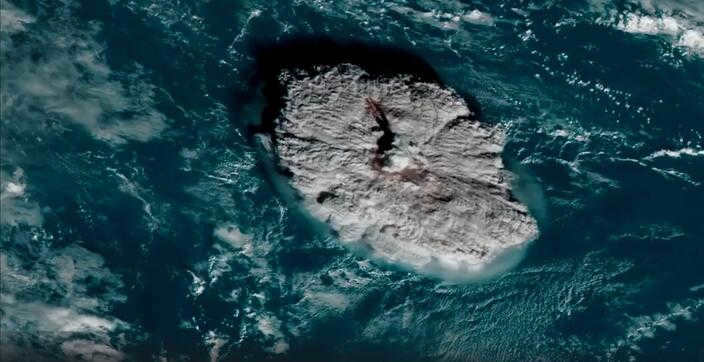
Transformation of Mexico’s Location
The movement of lithospheric plates has the potential to cause a catastrophic event on a global scale. In the past, the Mexican state of Oaxaca experienced a devastating earthquake with a magnitude of 7.5. This seismic activity resulted in the destruction of numerous homes and tragically claimed the lives of ten individuals.
However, the aftermath of this natural disaster revealed an even more puzzling phenomenon. Satellite maps provided by NASA indicated a shift in the coordinates of Mexico, with a displacement of 45 centimeters. The cause and mechanism behind this unexpected occurrence remain a mystery to scientists.
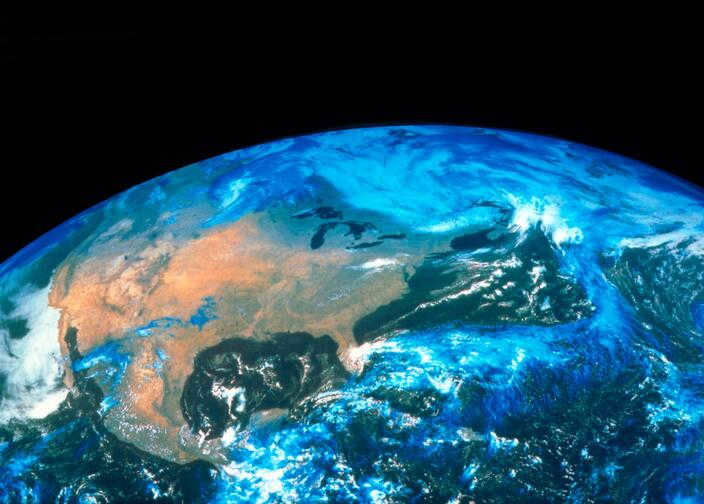
What is in store for our planet?
Mexico is situated entirely on the North American plate. If the country’s coordinates have shifted by nearly half a meter, it signifies that the whole continent has shifted. A powerful earthquake is merely the beginning. It is almost terrifying to contemplate the irreversible processes occurring within the continent’s interior.
As per scientific calculations, the North American plate is moving southwest at a speed of 3 centimeters per year. In 10 million years, it will collide with the South American plate, giving rise to a new supercontinent. The Caribbean Sea will vanish, and new mountains will emerge at the junction.
Discover the most enigmatic and captivating destinations on our planet, explore fascinating cultural traditions, delve into incredible narratives, and so much more – all on the NII program on REN TV.

Images: zen.yandex.ru and from the site Pixabay
Research suggests that the discovery of modern human remains in Greece dates back approximately 210,000 years. Our planet has been in existence for around 4.5 billion years. This means that humans have only been present for a mere 0.004% of the Earth’s entire lifespan. You can read more about this on zen.yandex.ru in the Unknowable section:
"Although we may perceive our existence as lengthy, it actually represents less than 1% of the total history of our planet. And even within this relatively short period of time, we have witnessed firsthand the transformations taking place on our planet.
Consider the case of the Sahara’s history: approximately 5-7 thousand years ago, it was a lush and verdant region, but today it stands as one of the most perilous deserts on the globe. Even early African maps showcased forests, rivers, and thriving settlements within this expanse, alongside bustling trading cities. Yet now, all these riches lay buried beneath countless tons of glistening sand.
An ancient Sahara map dating back to the 2nd century BC.
If such transformations can occur within a relatively compressed timeframe, what lies in store for our planet in the distant future? Let us maintain an optimistic outlook and envision a scenario where humanity does not succumb to self-destruction, continuing to thrive upon our beloved Blue Planet.
In the future, the tenth millennium will bring about a significant change in humanity.
As time progresses, our uniqueness will diminish as genetic variations fade away, resulting in a homogenous appearance for all individuals. Currently, we observe diversity in terms of skin color, eye and hair colors, and facial features. However, in the future, these distinctions will gradually disappear, causing us to amalgamate into a single human race. Furthermore, it is even plausible that we will adopt a universal language, which will be the sole means of communication across the entire planet.
Interestingly, our ancient ancestors originally shared a similar appearance. However, as they dispersed and settled on different continents, environmental factors led to the development of distinct physical characteristics. In the future, we will revert back to a state of similarity, resembling our ancestors once again.
It is also a possibility that if humans were to achieve genetic homogeneity, they may ultimately be outbred by congenital abnormalities. There may be a small number of survivors scattered across different regions of the globe, who will once again undergo changes due to environmental influences. This will result in the resurgence of racial and genetic diversity. That is, of course, if anyone manages to survive.
It is crucial to consider the biological aspect as well. Within the next 200 years, or even sooner, the planet will face a scarcity of resources such as oil, gas, and other hydrocarbons. Furthermore, nuclear energy and renewable sources like hydroelectric power plants and wind turbines will be insufficient to meet the energy demands of civilization in approximately 50 years.
Scientists predict the emergence of a universal language in the future, which means that even if people in the 21st century become multilingual, they will still struggle to understand the language spoken by future generations.
Currently, we are fortunate to inhabit a planet with a comfortable and warm climate. However, this favorable condition will not last forever. Throughout Earth’s history, there have been cyclical periods of glaciation, during which glaciers covered extensive areas, including equatorial zones. The only refuge from the cold during these periods was either underground or underwater near hydrothermal springs.
During these glaciation periods, most organisms were unable to survive the extreme changes in temperature and the scarcity of food. The occurrence of glaciation is attributed to a combination of astronomical factors, climate feedback mechanisms, and plate tectonics.
Currently, the Earth is experiencing an interglacial period that is projected to conclude in 25,000 years. However, the significant impact of human activity, which contributes to the greenhouse effect, has the potential to delay the onset of the next ice age for a minimum of 50,000-130,000 years and potentially save the planet from glaciation.
Nevertheless, the consequences of the ice age will still be felt, given that fossil fuels are expected to be depleted by approximately 2200. Consequently, as the atmospheric composition shifts once again, it will be necessary for us to acquire fur coats and fur hats.
100,000 years in the future.
The transformations in the celestial expanse will no longer be minor, but rather drastic – there will be no familiar constellations, not even the renowned “Ursa Major.”
In 500,000 years.
Humanity will still reach the Red Planet, and by that time, we will have managed to fully conquer it to the extent that walking on its surface without spacesuits and even without breathing apparatus will become possible.
In this timeframe, it is highly probable, based on statistics, that a substantial meteorite will collide with Earth, potentially resulting in a catastrophe on the same scale as the one 65 million years ago. Therefore, the fate of our planet is in the hands of people, and it is likely that we have already developed the ability to defend against such extraterrestrial threats.
By the time a million years have passed, the average lifespan of humans will have experienced a significant increase, and it is improbable that humans will remain the same as they are presently. Technology will literally become integrated into our very beings.
A million years hence.
It is highly probable that humans will embark on the exploration of other stellar systems and establish colonies on other celestial bodies. Can you guess what will transpire? We will once again observe the emergence of racial distinctions!
What will become of Earth? Its fate will be determined by the actions of humans. If humans deplete all of Earth’s resources and seek out new habitats on other worlds, with each race finding a new home, then Earth will have a chance to “rest”. However, its appearance will undergo such drastic changes that it will be unrecognizable.
After 250 million years.
A future supercontinent similar to ancient Pangea will form once again.
Within approximately 500 million years.
This supercontinent will eventually start to break apart. However, Earth’s status as a Blue Planet will not last much longer. Therefore, despite our love for Earth, we will need to search for a new home.
Within 800 million to 1 billion years, the Sun’s luminosity will intensify to the point where all the water on Earth will evaporate, leaving behind only scorched rocks in a lifeless desert.
Despite all that it has provided for us, the Earth will eventually perish on its own – no amount of technology can save it.
In another 4 billion years, when the Sun transforms into a red giant, it will consume Mercury, Venus, and possibly even Earth. Afterwards, as it sheds its outer layers, the Sun will also meet its demise.
The only thing left of the sun is a small white dwarf, which serves as a distant memory of the days when different civilizations flourished under the warm golden light of their celestial home. Now, these civilizations navigate the vastness of the galaxy, cherishing their shared history.
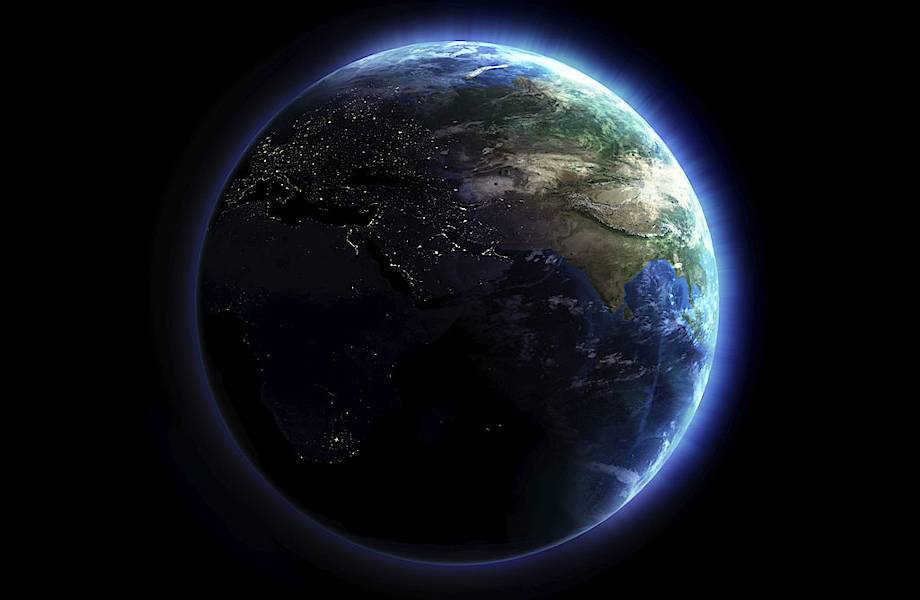
Forecasting the future of the Earth is akin to predicting the weather: as you look further ahead, the accuracy of speculation diminishes. Thus, it may appear impossible to predict the planet’s future. However, this is not entirely accurate: we have a wealth of 4 billion years of history to draw upon. By gaining a general understanding of the Earth’s past trajectory, we can utilize concepts such as evolution, extinction, plate tectonics, and climate change to shape the destiny of our planet for the foreseeable future.
One of the fundamental facts about our planet is that it is a celestial body that undergoes rotational and orbital movements. These motions have significant implications for the existence of living organisms. For instance, Earth not only spins on its axis but also experiences a change in its orientation. This phenomenon, known as precession, occurs approximately every 26,000 years, causing the axis to align with a different region of the sky. At present, the North Pole is directed towards Polaris, commonly known as the North Star. In approximately 13,000 years, Vega will take over as the new indicator of the northern direction. Furthermore, after 50,000 years, Earth will have completed two full precession cycles and returned to its current state.
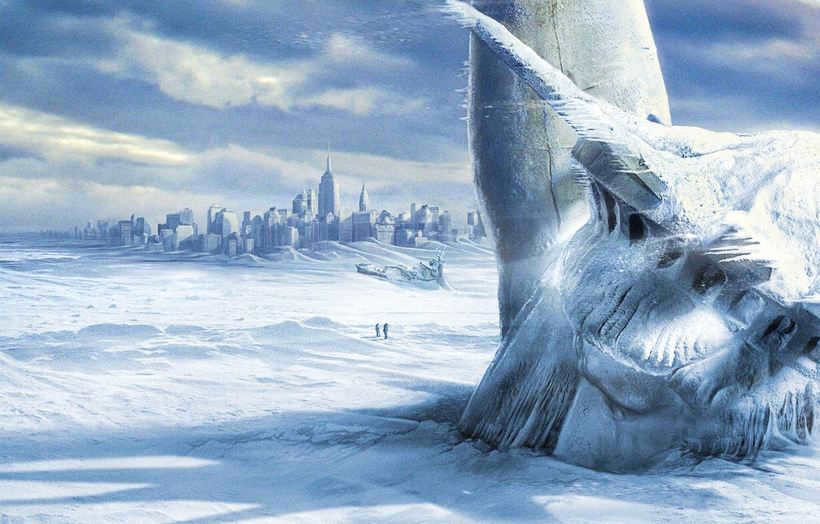
The alterations caused by the Earth’s axis tilt and the variation in its orbit around the Sun are even more noteworthy. Over the course of the 97,000-year cycle, the Earth’s orbit transforms from a perfect circle to an elliptical shape. Concurrently, the tilt of the Earth’s axis undergoes a slight fluctuation, ranging between 22.1 degrees and 24.5 degrees. Collectively, these modifications have a substantial impact on the amount of solar energy that our planet receives.
When the planet is in a more “upright” position, it undergoes an ice age: a thick layer of snow and ice blankets a significant portion of the land. Throughout history, ice ages have lasted for approximately 100,000 years, while warmer interglacial periods have endured for about 10,000 years. Currently, the Earth is experiencing one of these interglacial periods, but it will eventually transition into a new period of glaciation.
Many scientists predict that the next ice age will reach its peak in roughly 80,000 years. Consequently, in 50,000 years, the Earth will likely be considerably colder, and an icy crust will encase regions below New York City.
However, the initial phase will be characterized by high temperatures
What about the widely discussed phenomenon of global warming? How will it impact the potential scenario of the next ice age?
According to scientists, the long-term effects will be minimal. However, in the immediate future, global warming has the potential to bring about drastic changes to our planet. These changes will be evident over the course of the next two centuries. During this time frame, the levels of carbon dioxide in the atmosphere will surpass any recorded levels in the past 650,000 years. The presence of carbon dioxide will hinder the reflection of solar energy back into space, ultimately leading to a significant increase in the Earth’s temperature.
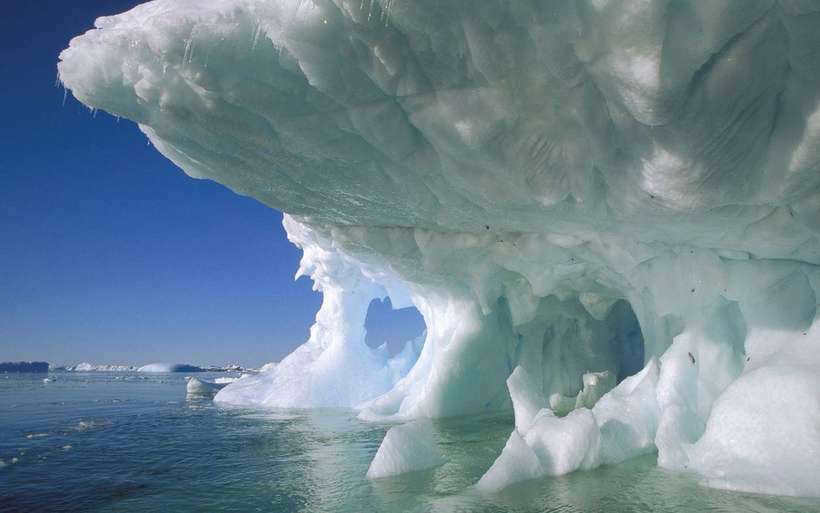
With the rise in average temperatures, the melting of glaciers and the subsequent rise in sea levels will cause devastating flooding along the coasts. Additionally, the warming and acidification of the oceans will have a catastrophic impact on coral reefs, leading to their widespread destruction. This, in turn, will result in the extinction of numerous marine species. Furthermore, the effects will not be limited to the oceans, as a significant portion of both plant and animal species on land will also vanish forever.
It will be a crucial period for our planet, and it might appear that things couldn’t get any more dire. Regrettably, the history of Earth reminds us that global cataclysms occur periodically, and there is no way to elude them.
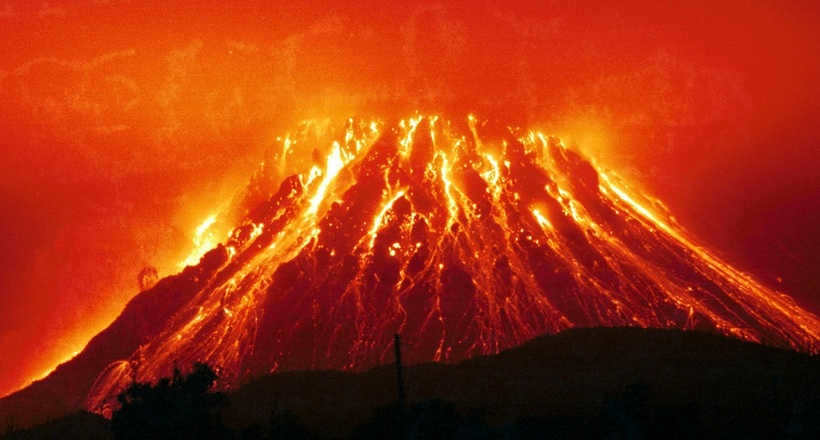
In the next 50,000 years, it is highly likely that we will encounter a cataclysmic event that will permanently alter the Earth. While the Earth has been struck by comets and asteroids in the past, this occurs on average only once every million years, so we can take solace in the fact that we have a grace period for the next 50,000 years. However, a much greater threat lies within the Earth itself: the same geological forces that cause continents to shift and drift also have the potential to awaken supervolcanoes. The resulting ash and smoke emitted from these eruptions can linger in the atmosphere for 10-15 years, blocking the sun’s rays. Geologists estimate that such eruptions occur every 50,000 years, so the odds are not in our favor in this regard.
By HowStuffWorks.com
Join our Telegram community, where there are already over 1 million members! 😍
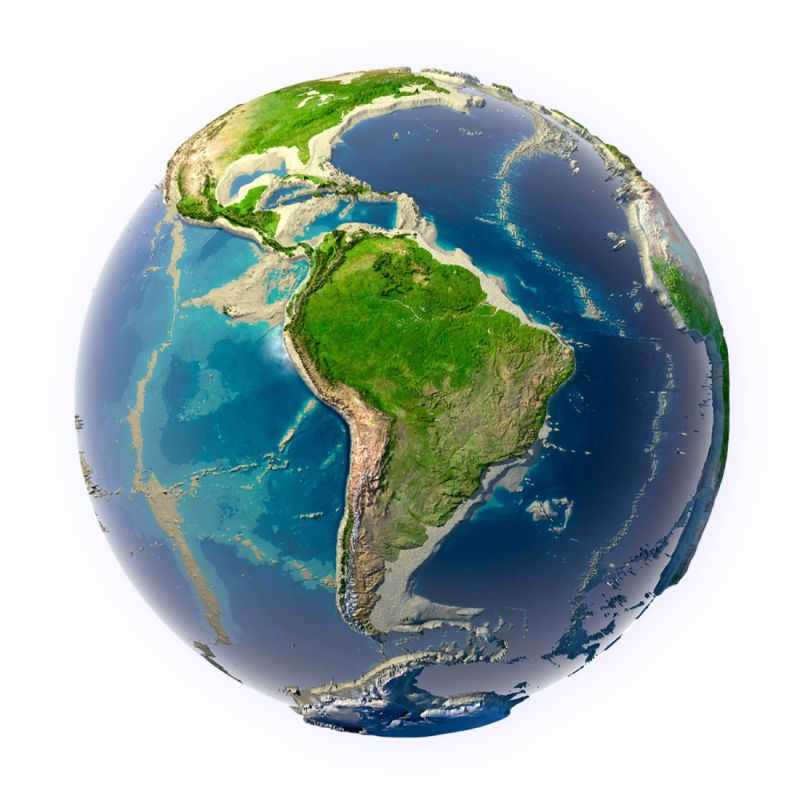
In my opinion, when scientists make predictions about the future 50-100 years from now, it is simply a speculative guess. However, when they make predictions about the Earth’s condition millions of years from now, based on the same amount of time that has already passed, it is likely to be a more accurate forecast.
Let’s consider what might happen to our planet in 5 billion years, given that it is currently 4.54 billion years old. This estimation is derived from radioisotope dating of meteorites (chondrites) that formed prior to the formation of planets. What if a similar amount of time elapses again?
While humanity may not be relevant at that point, what about the planet itself?
Getting hotter, hotter

In the next 100 to 1000 years, our planet will undergo significant changes. The average temperature will rise, leading to water flooding coastal cities. Additionally, the Gulf Stream will weaken, and the Sahara Desert will expand. These changes in the environment will also result in the extinction of some animal species.
Residents living near the coast will face significant challenges, but this is only the beginning. The entire population of Europe, which currently benefits from the warmth provided by the Gulf Stream, could be affected. The Gulf Stream is a current that relies on the temperature difference between the equator and high latitudes. If global warming continues to reduce this temperature difference, some climate models suggest that the “heater” for Europe may transform into an icy landscape within a century. At the very least, the warming effect will diminish significantly or even cease altogether. This potential outcome is particularly alarming for countries like Great Britain, whose climate may become comparable to that of Siberia.
Thanks to the increasing temperatures, the Sahara desert is already spreading northward, transforming the previously arable land of Morocco into a barren wasteland. Unsurprisingly, this phenomenon is having a detrimental effect on the local wildlife. As a result of the rapid ice melt, the population of polar bears, polar foxes, and emperor penguins is dwindling. However, it is not just the fauna of the northern regions that is facing challenges; the southern fauna, including koalas, pandas, gorillas, and the stunning pink flamingos, are also at risk of extinction in the near future.
Planet Fever: A Unique Perspective on Planetary Exploration

In the time span of 50,000 to 100,000 years from now, our planet will undergo significant transformations, including the shifting of continents and volcanic eruptions.
Despite the existence of global warming, it does not signify the end of ice ages. The Earth experiences cycles of cooling and warming every 100,000 to 20,000 years, which are influenced by factors such as the planet’s movement around the Sun and the tilt of its axis. In the next 50,000 years, what lies ahead for us?
Wind and extraterrestrial beings

When: 1-50 million years from now
What: Changes in continental shape, asteroid impact.
It’s not only water that erodes rocks, but also wind. Surprisingly, in a million years, this will contribute to the alteration of the world map, making it slightly different from the map we know today. This transformation will be further facilitated by the fluctuations in oceans and the shifting of continents, which will have moved approximately 45-60 km from their current positions by then. The impact will be particularly noticeable on coastal areas.
As an illustration, certain volcanic islands or Calvert County in southern Maryland (USA) – its rugged shoreline will undergo complete “weathering” within 50,000 years. Conversely, other nations will expand their landmass. Among the fortunate ones is Hawaii, boasting a youthful active volcano that has already ascended to 3,000 meters, albeit still submerged. In a million years, it will transform into a fully-formed island. It has even been bestowed with the name – Loihi (after the volcano itself).
Scientists have determined that the Earth is periodically hit by large asteroids, similar to the one that caused the extinction of the dinosaurs 65 million years ago. Although mankind has yet to encounter extraterrestrial life, it is only a matter of time. In 2029, the well-known asteroid Apophis, with a diameter of 325-340 meters, will come close to the Moon’s orbit, and on its next orbit, it will pass even closer to Earth. This pattern is expected to continue, and scientists predict that within the next 50 million years, our planet will collide with an alien asteroid. The consequences for humanity remain uncertain.

In the future, specifically 250 million years from now, there will be the formation of a brand new supercontinent.
In the past, continents have undergone repeated cycles of fragmentation and amalgamation to create a singular supercontinent. At present, these once-disintegrated segments are gradually converging once again, albeit at a slow and steady pace of 2-5 centimeters per year. Consequently, it is anticipated that in approximately 20 million years, the global cartographic landscape will necessitate revision, as the Atlantic Ocean expands by several hundred kilometers while the Pacific Ocean simultaneously contracts by a similar distance. Moreover, Australia will shift northwards towards South Asia over this extensive time period. Furthermore, within tens of millions of years, Africa, which is already in motion towards Europe, will ultimately seal off the Mediterranean Sea, giving rise to mountain ranges of such considerable height that the present-day Alps will appear minuscule in comparison. This new mountain range will span from the Atlantic to the Indian Ocean. Interestingly, in 100 million years, the Atlantic Ocean itself is projected to surpass the Pacific Ocean in size. Although the formation of the supercontinent will be well underway, the precise configuration remains unknown to scientists at present.
There are two primary versions. According to the first one, the Atlantic Ocean will continue to expand, leading to the convergence of both Americas with Asia, Australia, and Antarctica. North America will subsequently block off the Pacific Ocean and collide with Japan, while South America will curve and join Antarctica. The resulting continent, extending from east to west along the equator, is referred to as New Pangea.
The second version suggests that both Americas will collide with Europe and Africa, while Australia and Antarctica will converge with Southeast Asia. This would create a supercontinent shaped like the letter L, known as Amazia.
Heatstroke
Heatstroke is a medical condition caused by prolonged exposure to high temperatures. It occurs when the body’s core temperature rises above 104 degrees Fahrenheit (40 degrees Celsius). Heatstroke can be life-threatening and requires immediate medical attention. Signs and symptoms of heatstroke include a high body temperature, rapid heartbeat, headache, dizziness, nausea, confusion, and loss of consciousness. Heatstroke can be prevented by staying hydrated, avoiding prolonged exposure to high temperatures, and taking breaks in a cool and shaded area. If someone is experiencing heatstroke, it is important to move them to a cool place, remove excess clothing, and cool them down by applying cold water or ice packs to their body.

When: 1-5 billion years in the future
What: The Sun’s luminosity will increase, causing the oceans to evaporate, resulting in the transformation of Earth into a desert.
It is a known fact that the Sun is gradually warming up. When our planet formed 4.5 billion years ago, the Sun’s luminosity was only 70% of what it is today. Over the course of 2.4 billion years, its luminosity has increased to 85%. In another billion years, our star will shine even brighter.
As the Sun’s luminosity continues to rise, the oceans will slowly start to evaporate. Eventually, the glaciers will completely disappear, and the once icy polar regions will turn into tropical zones. Although life may still persist, the relentless heat from the Sun will cause hydrogen to escape into space, leading to the gradual drying up of the Earth and its eventual transformation into a desert.
After that, the Sun itself will deplete its hydrogen supply, which means that in approximately 5 billion years, it will enter its dying phase. This phase will be quite magnificent, as the Sun will expand and engulf Mercury, followed by Venus, and eventually reach Earth. Scientists hold differing opinions on whether it will completely consume Earth or simply come close to its orbit. However, even in the most optimistic scenario, our once-blue planet will be incinerated, reduced to charred remains where not even apple trees can thrive, let alone mold in a jar. Nevertheless, deep within the depths of the Earth, microorganisms may manage to survive for another billion years.
This information is based on the book “History of the Earth: From Stardust to a Living Planet” by Robert Hazen.
A new supercontinent called Amazia is currently in the process of forming on our planet.
What exactly occurred?
Scientists from Australia have demonstrated the possible transformations our planet will undergo in the next 300 million years.
According to their findings, a new supercontinent is expected to form on Earth during this time period.
Insights from the scientific community
In the past, scientists have attempted to anticipate the future of our planet and humanity, including exploring potential scenarios for the extinction of all life.
Over the course of several centuries, the landscape of different regions will be altered due to the effects of global climate change. Tundra regions and certain rivers may cease to exist.
What is going to happen
Scientists from Curtin University in Australia predict that a new supercontinent will emerge in the next 200-300 million years, replacing the current Pacific Ocean. This extraordinary event will occur as a result of the collision between the existing continents.
In the past 2 billion years, Earth’s continents have repeatedly collided, leading to the formation of supercontinents approximately every 600 million years. This suggests the existence of a supercontinental cycle, indicating that the present-day continents will eventually come together again in a few hundred million years.
Chuan Huang
co-author of the study
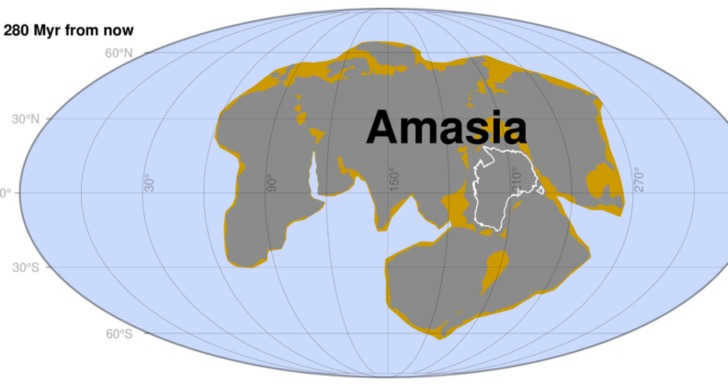
- Nuna, the oldest supercontinent whose existence has been scientifically proven, emerged 1.8 billion years ago, followed by Rodinia 1 billion years ago, and Pangaea 300 million years ago.
- By simulating the anticipated movement of Earth’s tectonic plates, geologists have generated a projection of how the planet will look like 300 million years in the future.
Additional Information
The researchers have put forward a suggestion to call the recently discovered landmass Amazia.
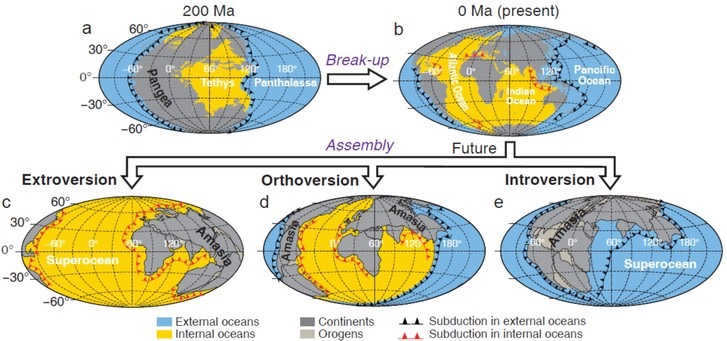
- The future Earth will have a unique geography. Its foundation will be formed by the merging of America and Asia. Australia will play a significant role in this process, as it will be the first to connect with Asia and then stabilize the tectonic plates.
- As a result of these geological changes, the Pacific Ocean will cease to exist, and the remaining oceans will merge into one superocean.
- The formation of the supercontinent, known as Amazia, will lead to a change in sea levels across the globe. Various regions will experience lower sea levels compared to the present day. Additionally, the interior of Amazia will face extreme weather conditions, including droughts and significant fluctuations in daily temperatures.
Scientific Findings
Prior to now, scientists had attempted to make predictions about the future changes that would occur on Earth.
In the year 2021, a global team of scientists made projections regarding the impacts of climate change on our planet.
- According to scientific research, even if carbon dioxide emissions were to cease immediately, the greenhouse effect would not diminish until many decades later. This implies that global warming will persist for centuries to come. Consequently, climate zones and the vegetation in various regions may undergo dramatic transformations by the year 2500. For instance, a significant portion of the Amazon basin would be transformed into an arid wasteland.
- An alternative scenario involves the rise in sea levels. Scientists speculate that, in such a scenario, the landscape could undergo such drastic changes that numerous areas would become uninhabitable.
Experts have also examined potential scenarios for the extinction of life on our planet, such as the eruption of a supervolcano or a collision with an asteroid.
- Supervolcanic eruptions have occurred in the past, specifically 200, 180, and 65 million years ago. Scientists predict that such an event will happen again at some point, but the outcome will depend on where the lava breaches the Earth’s crust. In the past, an eruption 250 million years ago caused the extinction of over 80% of species. However, it was primarily the salt deposits in Siberia that played a crucial role in their demise. These deposits, when heated by volcanic activity, released a significant amount of ozone-depleting chemicals into the atmosphere. Consequently, the Earth was exposed to a substantial dose of solar radiation.
- The outcome of a collision with an asteroid is also influenced by the location where the celestial body would impact. If the asteroid were to strike sedimentary rock, it would result in a significant release of gases into the atmosphere, leading to climate change and causing a mass extinction event. However, asteroids of this magnitude collide with Earth approximately once every 500 million years, and even in such a scenario, the planet would not be completely destroyed: it would require a collision with a quasi-planet.
In the year 2021, NASA and Toho University in Japan made an announcement stating that they have successfully determined the precise date of the apocalypse. According to their calculations, all forms of life will cease to exist in 1,000,002,021. By this time, solar activity will result in deoxygenation, causing the Earth to completely deplete its oxygen levels and the ozone layer to vanish.
Global warming has the potential to significantly alter the landscape of Russia in the coming centuries.
- If greenhouse gas emissions continue to rise, it is predicted that the tundra region may eventually vanish from the map. Scientists estimate that by the year 2100, the summer temperatures in the Arctic could increase by up to 14 degrees Celsius. If this occurs, the taiga forest will gradually shift northward at a rate of approximately 30 kilometers every 10 years. However, the tundra ecosystem does not have the same opportunity to migrate, and as a result, its area will begin to rapidly decrease. According to projections, only about 6% of the Siberian tundra belt, which spans over 4,000 kilometers, will still exist in 500 years.
- Ecologists are also expressing concerns about the future of Russian rivers, particularly those in the Caucasus and Altai regions. During the summer months, these rivers rely on glacial meltwater for their water supply. However, with the accelerated melting of glaciers due to global warming, these rivers are at risk of losing their main source of water. Consequently, there is a high likelihood that the rivers will dry up during the summer season.

